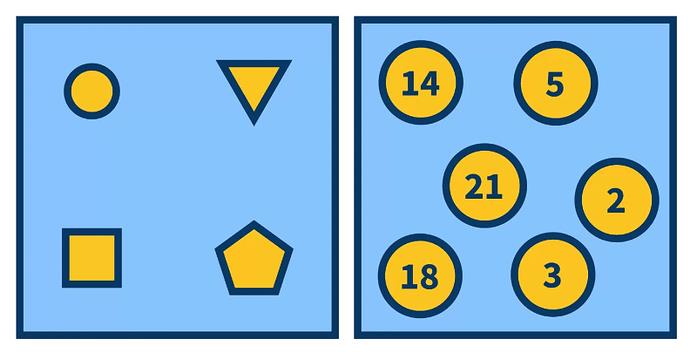Java 如何在 Array 和 Set 之间进行转换
Posted huyuchengus
tags:
篇首语:本文由小常识网(cha138.com)小编为大家整理,主要介绍了Java 如何在 Array 和 Set 之间进行转换相关的知识,希望对你有一定的参考价值。
概述
在本文章中,我们对如何在 Java 中对 Array 和 Set 进行转换进行一些说明和示例。
这些示例通过使用 Core Java 和一些第三方的转换工具,例如 Guava 和 Apache Commons Collections。
更多有关的文章,请访问:Java - OSSEZ 相关的内容和参与讨论。
从 List 转换为 Set
使用原生 Java 代码
让我们首先来看看如何在原生 Java 中把数组转换为 Set。
通过下面的代码,我们了解到首先需要把 Array 转换为 List,然后再把这个 List 转换为 Set。
@Test
public void givenUsingCoreJavaV1_whenArrayConvertedToSet_thenCorrect()
Integer[] sourceArray = 0, 1, 2, 3, 4, 5 ;
Set<Integer> targetSet = new HashSet<Integer>(Arrays.asList(sourceArray));
可选的,我们可以首先定义一个 Set 对象,然后把这个 Set 对象的元素进行填充:
@Test
public void givenUsingCoreJavaV2_whenArrayConvertedToSet_thenCorrect()
Integer[] sourceArray = 0, 1, 2, 3, 4, 5 ;
Set<Integer> targetSet = new HashSet<Integer>();
Collections.addAll(targetSet, sourceArray);
使用 Guava
我们可以使用 Guava 转换工具来把数组给出的数组来进行初始化。
@Test
public void givenUsingGuava_whenArrayConvertedToSet_thenCorrect()
Integer[] sourceArray = 0, 1, 2, 3, 4, 5 ;
Set<Integer> targetSet = Sets.newHashSet(sourceArray);
使用 Apache Commons Collections
最后我们可以使用 Apache 的 Commons Collection 的库来进行处理。
这个处理方法和我们使用原生 Java 代码差不多,首先需要对 Set 进行初始化,然后再把 Set 中的元素进行填充。
@Test
public void givenUsingCommonsCollections_whenArrayConvertedToSet_thenCorrect()
Integer[] sourceArray = 0, 1, 2, 3, 4, 5 ;
Set<Integer> targetSet = new HashSet<>(6);
CollectionUtils.addAll(targetSet, sourceArray);
从 Set 转换为 Array
使用原生 Java
Set 中有一个 toArray 的方法,你可以直接使用这个方法来把给出的 Set 转换为 Array。
@Test
public void givenUsingCoreJava_whenSetConvertedToArray_thenCorrect()
Set<Integer> sourceSet = Sets.newHashSet(0, 1, 2, 3, 4, 5);
Integer[] targetArray = sourceSet.toArray(new Integer[0]);
需要注意的是,我们在这里使用了 toArray(new T[0]) 来对变量进行初始化,相对使用 toArray(new T[size]) 这个方法。
使用 toArray(new T[0]) 来对数组进行初始化更加安全,快速,易读。
使用 Guava
下一步,让我们来使用 Guava 的 API 来进行转换。
@Test
public void givenUsingGuava_whenSetConvertedToArray_thenCorrect()
Set<Integer> sourceSet = Sets.newHashSet(0, 1, 2, 3, 4, 5);
int[] targetArray = Ints.toArray(sourceSet);
Ints 中有一个 toArray 的方法,这个方法将会把整数类型的 List 转换为 Array。
需要注意的是 Ints 的类型需要和数组中的类型进行匹配才可以。
结论
在 Java 的集合类型直接进行转换是我们需要经常进行操作的方法和需求。
Guava 的方法 Sets 中通常能够对 Set 进行比较好的操作,包括对 Set 的对象进行初始化。
我们可以用这个对象中的初始化参数来对数组转换为 Set。
使用 Commons Collections 还是有点晦涩。
JavaScript判断对象是否包含特定属性和Map,Set,Array,Object之间的相互转换-案例
hasOwnProperty
Object的
hasOwnProperty()方法返回一个布尔值,判断对象是否包含特定的自身(非继承)属性
判断自身属性是否存在
var o = new Object();
o.prop = 'exists';
function changeO() {
o.newprop = o.prop;
delete o.prop;
}
o.hasOwnProperty('prop'); // true
changeO();
o.hasOwnProperty('prop'); // false判断自身属性与继承属性
function foo() {
this.name = 'foo'
this.sayHi = function () {
console.log('Say Hi')
}
}
foo.prototype.sayGoodBy = function () {
console.log('Say Good By')
}
let myPro = new foo()
console.log(myPro.name) // foo
console.log(myPro.hasOwnProperty('name')) // true
console.log(myPro.hasOwnProperty('toString')) // false
console.log(myPro.hasOwnProperty('hasOwnProperty')) // fasle
console.log(myPro.hasOwnProperty('sayHi')) // true
console.log(myPro.hasOwnProperty('sayGoodBy')) // false
console.log('sayGoodBy' in myPro) // true遍历一个对象的所有自身属性
for...in循环对象的所有枚举属性,然后再使用hasOwnProperty()方法来忽略继承属性
var buz = {
fog: 'stack'
};
for (var name in buz) {
if (buz.hasOwnProperty(name)) {
alert("this is fog (" + name + ") for sure. Value: " + buz[name]);
}
else {
alert(name); // toString or something else
}
}注意 hasOwnProperty 作为属性名
JavaScript 并没有保护
hasOwnProperty属性名,因此,可能存在于一个包含此属性名的对象,有必要使用一个可扩展的hasOwnProperty方法来获取正确的结果
var foo = {
hasOwnProperty: function() {
return false;
},
bar: 'Here be dragons'
};
foo.hasOwnProperty('bar'); // 始终返回 false
// 如果担心这种情况,可以直接使用原型链上真正的 hasOwnProperty 方法
// 使用另一个对象的`hasOwnProperty` 并且call
({}).hasOwnProperty.call(foo, 'bar'); // true
// 也可以使用 Object 原型上的 hasOwnProperty 属性
Object.prototype.hasOwnProperty.call(foo, 'bar'); // true衍生常用方法
Map,Set,Array,Object之间的相互转换
- Object.entries获取对象的键值对
- Object.FromEntries把键值对列表转成对象
- Object.entries和Object.fromEntries之间是可逆的
Object转Map
let obj={foo:'hello',bar:100};
let map=new Map(Object.entries(obj));
console.log(map)Map转Object
方式一:
[...map.entries()].reduce((obj, [key, value]) => (obj[key] = value, obj), {})
方式二:
let map=new Map([['foo','hello'],['bar',100]]);
let obj=Object.fromEntries(map);
console.log(obj);Object转Array
let obj={'foo':'hello','bar':100};
let arr=Object.entries(obj);
console.log(arr);Array转成Object
let arr=[['foo','hello'],['bar',100]];
let obj=Object.fromEntries(arr);
console.log(obj);Array转Set
let arr=[['foo','hello'],['bar',100]];
let set=new Set(arr);
console.log(set)以上是关于Java 如何在 Array 和 Set 之间进行转换的主要内容,如果未能解决你的问题,请参考以下文章
